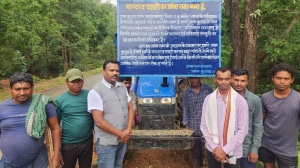IRAN’S SUPREME Leader Sayyid Ali Hosseini Khamenei on Monday listed India along with Gaza and Myanmar as one of the places where Muslims are suffering. Reacting to this, India “strongly deplored” the comments and called them “misinformed” and “unacceptable”.
In a post on X, Khamenei said, “The enemies of Islam have always tried to make us indifferent with regard to our shared identity as an Islamic Ummah. We cannot consider ourselves to be Muslims if we are oblivious to the suffering that a Muslim is enduring in #Myanmar, #Gaza, #India, or any other place.”

Hours later, the Ministry of External Affairs issued a sharply worded statement titled, “Statement on Unacceptable Comments made by the Supreme Leader of Iran”. It said, “We strongly deplore the comments made regarding minorities in India by the Supreme Leader of Iran. These are misinformed and unacceptable. Countries commenting on minorities are advised to look at their own record before making any observations about others.”
Story continues below this ad
Incidentally, Khamenei’s comment came on the second anniversary of Mahsa Amini’s death. The 22-year-old Iranian woman was arrested for protesting against the hijab and beaten to death in police custody, leading to outrage and massive protests in Iran.
Although this is not the first time Iran’s spiritual leader has named India as a place where Muslims are suffering, it is unclear what provoked him to make the latest comment.
 Khamenei’s remarks, regarding minorities in India, triggered a swift backlash from the Indian government. The Ministry of External Affairs (MEA) condemned the comments as “misinformed and unacceptable.”
Khamenei’s remarks, regarding minorities in India, triggered a swift backlash from the Indian government. The Ministry of External Affairs (MEA) condemned the comments as “misinformed and unacceptable.”
In March 2020, after the north-east Delhi riots sparked criticism, Khamenei had called the riots a “massacre of Muslims” and had called on India to confront “extremist Hindus and their parties” to prevent its “isolation from the world of Islam”.
Khamenei, who has been Iran’s spiritual leader since 1989, had tweeted: “The hearts of Muslims all over the world are grieving over the massacre of Muslims in India. The govt of India should confront extremist Hindus & their parties & stop the massacre of Muslims in order to prevent India’s isolation from the world of Islam.” He had then concluded the tweet with a hashtag: #IndianMuslimslnDanger.
Story continues below this ad
In August 2019, Khamenei had expressed concern over the situation of Muslims in Kashmir, two weeks after the government revoked Article 370 in Jammu and Kashmir.
“We’re concerned about Muslims’ situation in Kashmir. We have good relations with India, but we expect the Indian government to adopt a just policy towards the noble people of Kashmir and prevent the oppression & bullying of Muslims in this region,” he had tweeted. India had rejected his comments.
Tehran had last criticised India after the 2002 Gujarat riots and, a decade earlier, after the 1992 Babri Masjid demolition.
While 1992, 2002 and 2020 are moments when Khamenei spoke out on Indian Muslims, he has time and again raised the issue of Kashmir, the last being in August 2019.
Story continues below this ad
Before that, he had mentioned Kashmir in 2017 — for the first time in seven years — when he said, “The Muslim world should openly support the people of Yemen, Bahrain, and Kashmir and repudiate oppressors and tyrants who attacked [them].”
The last time violence in J&K was explicitly brought up by Iranian leaders was in 2010, when not just the Iranian supreme leader, but also the country’s foreign ministry raised questions about Kashmir.
In July and November of 2010, Khamenei had raised the need for the Muslim community to support the “struggle” in Kashmir – and put it in the same category as Gaza and Afghanistan.
Iran’s rhetoric on Kashmir had increased in 2010 in the backdrop of Iranian concerns over the India-US civil nuclear deal. In 2008 and 2009, India had voted against Iran at the International Atomic Energy Agency.



 Khamenei’s remarks, regarding minorities in India, triggered a swift backlash from the Indian government. The Ministry of External Affairs (MEA) condemned the comments as “misinformed and unacceptable.”
Khamenei’s remarks, regarding minorities in India, triggered a swift backlash from the Indian government. The Ministry of External Affairs (MEA) condemned the comments as “misinformed and unacceptable.”





